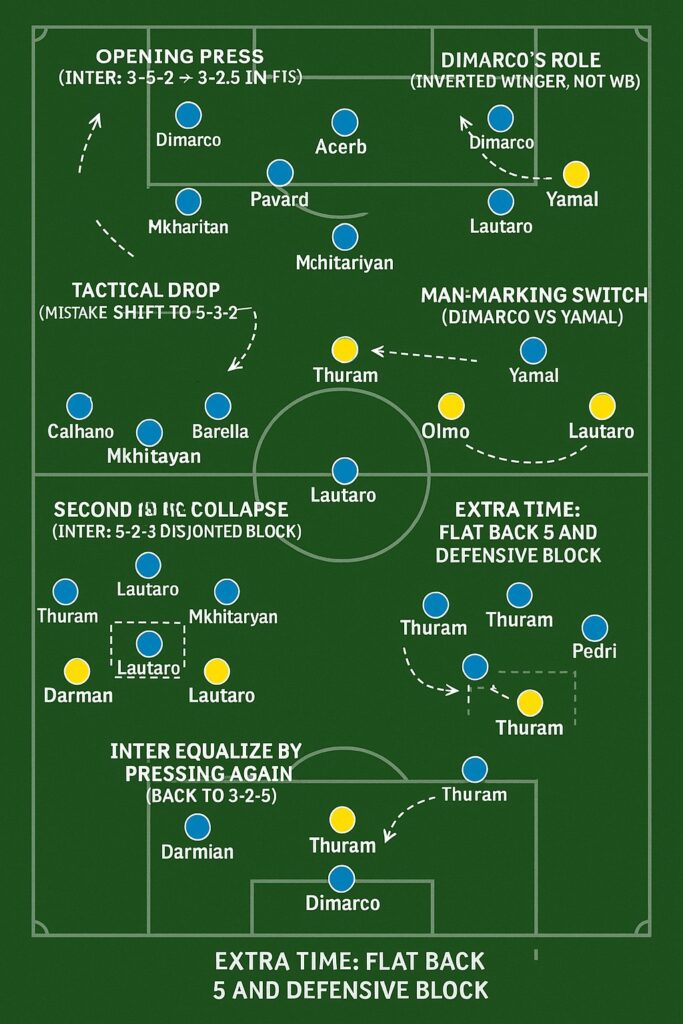The second leg clash between Inter Milan and Barcelona delivered a dramatic and tactically encounter that hinged not just on formations, but on mentality, execution, and in-game decisions. The match was a case study in tactical evolution and mental resilience.
Opening Press and Formation Fluidity:
Inter Milan began the match with a high-octane press, mirroring their approach from the first leg. Lining up in a 3-5-2 formation, they quickly shifted into a 3-2-5 when in possession. The back three pushed high, with wing-backs advancing into midfield to support the press. The midfield trio of Barella, Calhanoglu, and Mkhitaryan executed a tight, aggressive shape, swarming Barcelona’s midfielders and suffocating their build-up play.
Barcelona’s deep-lying playmaker, Frenkie de Jong, found himself under relentless pressure, unable to dictate the tempo or connect effectively with the front line. Inter’s intensity paid off with two early goals, both coming from turnovers won high up the pitch. Their approach was bold and fearless, setting the tone for what looked like a dominant performance.
DiMarco’s Hybrid Role:
One of the standout tactical wrinkles came from Federico DiMarco’s positioning. Rather than acting as a conventional wing-back, DiMarco operated almost like an inverted left winger. He hugged the touchline during buildup phases and then drifted centrally in the final third. This positioning disrupted Barcelona’s defensive shape, particularly in the first 20 minutes, giving Inter control of the left flank and helping them stretch the pitch effectively.
Game Management Error: The Call for ‘Calma’
After racing to a 2-0 lead, Simone Inzaghi signaled for composure, asking his players to slow the tempo and drop deeper. Inter retreated into a more conservative 5-3-2 shape, abandoning their aggressive press. This shift allowed Barcelona to regain possession and build rhythm.
Given Barcelona’s commitment to a high line and fluid 4-3-3 formation (which morphed into a 2-3-5 in attack), Inter’s retreat was ill-advised. Pedri and Frenkie de Jong began to find space in midfield, initiating a wave of controlled possession. The tactical retreat invited pressure, culminating in a well-taken Barcelona goal before halftime.
Dani Olmo: The Ghost Connector:
Barcelona’s attempt to use Dani Olmo as a false nine or free eight did little to disrupt Inter’s compact defensive block. Tasked with linking midfield and attack, Olmo was swallowed by Inter’s midfield triangle. His movements between the lines were ineffective, and he consistently failed to connect with Pedri or Lewandowski. Over two legs, Olmo’s presence had little tactical impact, rendering him invisible and isolated.
Second-Half Collapse: Inter Abandon Their Identity
The second half saw a noticeable drop in Inter’s structure and discipline. Thuram and Lautaro stopped tracking back, leading to dangerous gaps between midfield and defense. Inter’s organized 3-5-2 turned into a disjointed 5-2-3 without a central press. Barcelona exploited these spaces relentlessly, with Pedri finding joy in the crucial zone 14 area and carrying the ball unchallenged.
The tactical shift was not just about shape, it was about mentality. Inter showed signs of fear. Instead of pressing their advantage, they hesitated, and that hesitation was punished.
Football Is Mental:
Football is seventy percent mental. In this tie, that truth was on full display. Barcelona didn’t abandon their principles; they trusted their positional play and kept executing their 2-3-5 attacking structure. Inter, however, panicked. After taking the lead, Inzaghi switched from proactive football to conservative containment. That decision flipped the momentum and sowed doubt across his team.
Feratasi’s Introduction: A Reignited Flame:
In the midst of Inter’s second-half malaise, the introduction of Feratasi injected new life. His willingness to press high and make direct vertical runs disrupted Barcelona’s rhythm. His energy catalyzed a resurgence that led to Inter’s equalizer. The difference was simple: Inter started running again. The intensity returned, and so did their effectiveness.
Extra Time: Rebuilding the Wall
Inzaghi reverted to defensive solidity for extra time. Matteo Darmian came on to reinforce the back line, creating a compact flat five with Bastoni, Acerbi, and Pavard at the heart of it. DiMarco and Darmian dropped deep, forming a true back five.
Thuram was redeployed to drop into midfield, effectively giving Inter a 5-4-1 shape when defending. This conservative setup brought renewed discipline. A standout moment was Thuram tracking back to block a Pedri shot—symbolic of the collective spirit that had returned to the side.
Resilience Over Tactics:
The first half of extra time wasn’t about tactical adjustments—it was about presence. Inter didn’t change much structurally; they simply showed up. Every man committed, sitting deep, staying compact, and waiting for counter-attacking chances.
In all, Inter didn’t failed to build their 2 goals lead of this match not on tactics alone. They lost it on mentality and in-game discipline. The structure was there. The plan worked when they trusted it. But when they deviated, when fear crept in,they handed the advantage to Barcelona.
However, expect a different Inter in the final. They’ve shown they can play quality football, and this tactical shift was largely designed to cancel out Barcelona’s strengths. If they find the courage to stay committed to their identity for ninety minutes, they have what it takes to go all the way.
Should we send you latest update about your favourite sports and team?
Enter you email in the box below and hit the subscribe button to join our teaming 876+ sports community.
